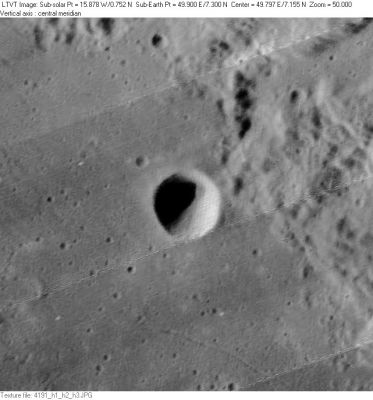Asada
Contents
Asada
(formerly Taruntius A)
|
Lat: 7.3°N, Long: 49.9°E, Diam: 12 km, Depth: 2.25 km, Rükl: 37 |
Images
LPOD Photo Gallery Lunar Orbiter Images Apollo Images
- Apollo 15's orbital Hasselblad photograph AS15-88-11971 shows Apollo 15's CSM Endeavour between craters Taruntius (left) and the bright bowl-shaped crater Asada' (right). Note the exposed SIM-bay in Endeavours Service Module.
- The bright and dark spokes on Asada's inner slopes were also captured on Apollo 17's orbital ITEK-panoramic frame AS17-P-2958 (about halfway of the frame).
- Apollo 10's Hasselblad AS10-30-4426 shows an oblique close up of Asada. Note that this image looks almost the same as the first one mentioned in the LPI's list of the Taruntius A (Asada) photographs, see: AS10-31-4563.
- Research orbital Apollo photographs: Danny Caes
Maps
(LAC zone 61C2) LAC map Geologic map AIC map LTO map
Description
Description: Wikipedia
Additional Information
- Depth data from Kurt Fisher database
- Westfall, 2000: 2.25 km
- Viscardy, 1985: 2 km
- Included in ALPO list of banded craters
Nomenclature
- Named for Goryu Asada (1734-1799), a Japanese astronomer who helped to introduce modern astronomical instruments and methods into Japan. Because of the Japanese government's policy of seclusion, Western scientific theory was generally available only through obsolete Chinese works edited by Jesuit missionaries in China. Yet Asada managed to construct sophisticated mathematical models of celestial movements and is sometimes credited with the independent discovery of Kepler's third law.
- The name Taruntius A was part of the original IAU nomenclature of Blagg and Müller (Catalog Entry 216). The name is attributed to Mädler.
- This replacement name for a formerly lettered crater was introduced on LTO-61C2 (1974). It was approved in IAU Transactions XVIB (1976). - Jim Mosher
LPOD Articles
Bibliography
